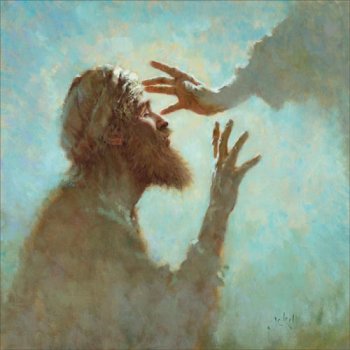"GOD FIRST: A WAY TO INNER CONVERSION AND COMMITMENT" PART II

God First: A Way to Inner Conversion and Commitment
Colors … We do love colors, don’t we? Well, not all colors probably, but each one of us could at least like one color. At times, we associate colors with our feelings and so when we say that we’re feeling blue, we actually mean that we feel sad and lonely; or when someone says, “I’m feeling red!” you better stay away from the person because that person could be having a bad day as the person is angry, or worse, filled with rage!
Today, the Fourth Sunday of Lent, we hear a very colorful story hand-painted by the Evangelist, St. John himself. Just like last Sunday’s Gospel as we’ve met the Samaritan Woman, we now come to meet another person. This time it is not a woman but a man. Though man, however, he was born blind. What can we learn from this dialogue? In line with our Lenten theme, “God First: A Way to Inner Conversion and Commitment,” how will God be first on this regard? Let me point out to you some points to reflect upon as I associate them with three different colors:
1. BLACK as to symbolize “Blindness.” We hear in today’s Gospel two types of blindness: a. Physical blindness – a circumstantial blindness, which in the case of the man in the Gospel, was acquired by birth; b. Spiritual blindness – contrary to physical blindness is a type blindness that’s deliberate, that is, out of one’s willingness, the person closes his/her sight from the true essence of what the Gospel is all about, as in the case of the Pharisees. When Jesus said, “I came to this world … so that those who do not see might see” he was actually referring to spiritual blindness.
There was a man in a psychiatric hospital one time, and one of his problems was that he was convinced he was dead. The psychiatrist tried every trick in the book, but nothing could change his mind. Finally, as he thought, he got a brilliant breakthrough. He got the man to agree that a corpse is lifeless, and therefore, not having any blood, it cannot bleed. Having got a clear acceptance of that simple fact, the psychiatrist proceeded to drive home the point. He got a pin, took the man's finger, and gave him a good enough prod to draw blood. He squeezed the finger until the blood was clearly evident, and he then proclaimed, 'Now can you see? That's blood. You are bleeding.'
The man looked at the blood in apparent disbelief, and then he turned to the psychiatrist with a look of amazement, and said, 'Well, what do you know! Corpses do bleed.'
Putting God first means allowing God to show us the light that would cure our spiritual blindness that we may be open to the truth that Christ teaches us.
2. Another color that is very prevalent in today’s Gospel is PINK for “Tolerance.” Toleranceis the ability to accept someone who is different, and not to be harsh in my judgments of things I don't fully understand. Prejudice comes from the idea of pre-judging, of passing judgment before all the facts are known. Just like in last Sunday’s Gospel, when we come to meet the Samaritan Woman, we went beyond knowing her gender, ethnicity and religious tradition. Through a very fruitful dialogue with an open-line of communication, we’ve reached a point of knowing her doubts, her fears, her anxieties. We’ve practiced tolerance in order that the woman would come to truly know who Jesus really is from being “Jew” to “Savior of the world.”
Putting God first on this regard means seeing beyond prejudices in order that we may truly see Jesus and in seeing Him, we will love him all the more.
3. Finally, we see strong shades of BLUE for “Hope” or “Determination,” and in the Gospel, it is the determination or willingness to see! The Pharisees did not have this attitude as they were arrogant enough to believe that they know everything. They weren’t able to see the true meaning of the Gospel but the blind man did. As he was determined to see, he followed exactly as Jesus directed him, to go to Siloam and wash his eyes to restore his sight.
Determination enables us to see beyond what our naked eyes could see. It gives us the feeling that motivates us to do more than expected. It gives us the spirit even if physically we’re unable to see. [See video clip below]
Seeing With Hope
Colors inspire us in a lot of ways as it could signify several things. We see shades of different colors in today’s Gospel as the Evangelist himself hand-painted them colorfully. However, it is up to us to make the colors work in the way we see life and in the way we open ourselves to the very meaning of life. John Milton in his poem, “In His Blindness” once said, “They also serve those who stand and wait.” Just like the blind girl in the clip and the blind man in the Gospel, they went beyond physical blindness by actually seeing the true meaning of life in hope and determination.






